What’s Under Your Kilt? Ghillie Brogues!

Most of us love wearing the kilt.
Dressing in our pipe band uniform or Scottish Highland wear fills us with pride.
Pipers talk about how comfortable the kilt is, but I’ve never heard anyone say that about their ghillie brogues! Given the amount of time we pipers stand around, the ghillies can range from mildly uncomfortable to downright torture.
In my early days of piping I purchased my ghillies a size too small, and then crammed them full of piper hose. In the middle of massed bands my feet started cramping so bad I thought I would pass out. I slipped out of the ranks and waddled over to the vendor area and purchased a pair that fit better, and got back in rank in time to march out of massed bands.
The fact that massed bands go on long enough for that is a subject for another day.
My point is that your feet are important and you should be sure you have good fitting shoes.
History
Once upon a time, a piper who was employed by a Highland laird typically had many other duties.
Often piping was a duty of a ghillie, or young servant.
The Gaelic term has been translated to both young boy and servant. His duties were varied but included such things as accompanying the laird while hunting in order to fetch the fallen prey and to carry the laird over streams and bogs.
The ghillie’s footwear consisted of a rudimentary shoe formed from a sheet of untanned leather. It had holes in the top portion to allow water to escape. It had no tongue to allow the foot to dry more quickly. And its laces were wrapped and tied around the leg so that a muddy bog or stream would not suck them off the feet.
These attributes made their way to a more formal shoe, most likely during the Victorian era when Highland wear was formalized among the Scottish gentry.
These attributes, once purely utilitarian, are now steeped in a tradition with roots that are unfamiliar to many.
Tying the Brogue
If you look around at pipers and drummers at the Highland Games, you’ll see all sorts of tying methods on the ghillie brogue.
I’ve seen web-worked laces that would be the envy of a spider, and some that look like there’s a contest to see how high up your leg you can get your laces.
If your band hasn’t prescribed a tying method for your ghillie brogues, try this three-step process for a neat, professional look.
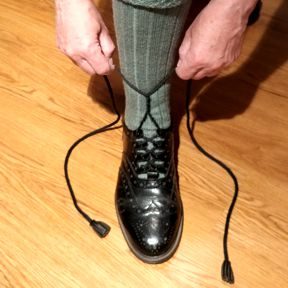 Step 1 – Do the Twist
Step 1 – Do the Twist
Some start by tying a half hitch, I don’t. Take the laces and twist them around each other 3 to 6 times (I use 3, occasionally 4 twists). Pull them tight, but not so tight that they bunch up.
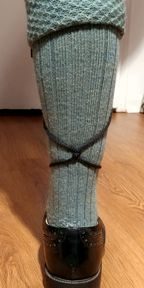 Step 2 – Wrap It Up
Step 2 – Wrap It Up
Pull the laces back behind your leg and then back around to the front. You can either add one or two twists in the back or not. I use both methods depending on my mood. Adding twists will make the laces sit higher on your legs. The twists can be difficult to center on the back of your leg, which is desirable for a neat look.
Step 3 – Tie One On
The laces can now be tied in a bow, either centered on the shin or off toward the outside of your leg, directly under your flashes. I’ve tried both ways, and prefer them centered. I always double knot, as it prevents the laces from loosening and sliding down the leg. They should be only an inch or two above your ankle.
If your laces are too long, you can wrap them twice around your leg at the top. Or preferably you can trim them to size so that one time around is all you need.
Tips
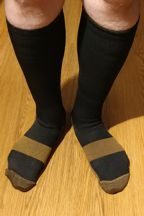 Many pipers I know wear compression hose or athletic socks under their hose. This can allow you to wear your hose more than once; it adds life to your hose, and it cushions your feet better.
Many pipers I know wear compression hose or athletic socks under their hose. This can allow you to wear your hose more than once; it adds life to your hose, and it cushions your feet better.- Go larger rather than smaller. Your feet will slide around in shoes that are too big, but shoes that are too small will squeeze the blood out of your toes. Keep in mind that after a few hours in uniform, standing and marching, your feet will swell a bit.
- Keep your shoes clean and polished. You’ve gone through all the trouble and expense of purchasing the proper shoe for your kilted attire, keep them looking good by brushing the dust and grass off them after wearing them, and polish them frequently. They'll last longer and resist dirt and moisture better.

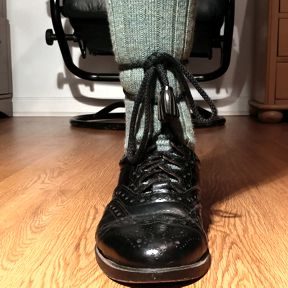
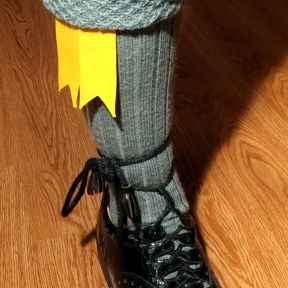





Responses